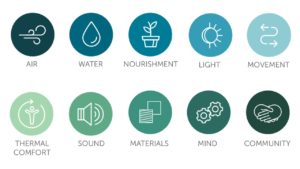Meeting the WELL V2.0 Standards
The WELL Building Standard™ version 2 (WELL v2™) is a vehicle for buildings and organizations to deliver more thoughtful and intentional spaces that enhance human health and well-being.
The 10 concepts of WELLv2

We are seeing more and more businesses and organisations seeking to reach these standards to ensure buildings are doing everything in their power to advance health and well-being to help people thrive.
Scored on a points based systems, these standards are backed by the latest scientific research with the aim to advance human health through design interventions and operational protocols and policies
WATER
The WELL Water concept covers aspects of the quality, distribution and control of liquid water in a building. It includes features that address the availability and contaminant thresholds of drinking water, as well as features targeting the management of water to avoid damage to building materials and environmental conditions.
The WELL Water concept aims to increase the rate of adequate hydration in building users, reduce health risks due to contaminated water and excessive moisture within buildings and provide adequate sanitation through better infrastructure design and operations coupled with awareness and maintenance of water quality.
There are three Preconditions (and 5 optimisations) in the Water Features that must be met in order to qualify for WELL certification:
—————————
Feature W01:
Fundamental Water Quality
Intent: Verify the quality of water for human contact through easy-to-test parameters.
Summary: This WELL feature requires the provision of water that meets thresholds for turbidity and coliforms for all water likely to come in contact with building occupants and verifies performance using on-site tests.
—————————
Feature W02:
Water Contaminants
Intent: Provide access to drinking water that complies with health-based limits on chemical composition.
Summary: This WELL feature requires projects to provide drinking water that meets thresholds on chemicals as published by research and regulatory organizations.
—————————
Feature W03:
Legionella Control
Intent: Implement protocols to reduce risk of water quality loss and Legionella colonization
Summary: This WELL feature requires projects to proactively test drinking water and to manage recirculating hot water systems against Legionella colonization.
—————————
Feature W04:
Enhanced Water Quality
Intent: Provide access to drinking water without unpleasant taste, odor and appearance.
Summary: This WELL feature requires projects to provide drinking water that meets thresholds on chemicals that affect aesthetics and taste concerns.
—————————
Feature W05:
Drinking Water Quality Management
Intent: Maintain and display consistent high quality of drinking water.
Summary: This WELL feature requires pre-testing of water quality parameters to determine treatment needs, monitoring at a more frequent interval and disclosure of water results.
—————————
Feature W06:
Drinking Water Promotion
Intent: Promote proper hydration through the consumption of drinking water over less healthy alternatives by promoting access to drinking water of verified quality.
Summary: This WELL feature requires readily available and maintained dispensers for drinking water.
—————————
Feature W07:
Moisture Management
Intent: Limit the potential for bacteria and mold growth within buildings from water infiltration, condensation and internal leaks.
Summary: This WELL feature requires projects to develop strategies to minimize the presence of unintentional water and, when unavoidable, to manage it through material selection and inspections.
—————————
Feature W08:
Hygiene Support
Intent: Ensure availability of bathrooms and support hygienic hand washing and toilet use practices for all individuals.
Summary: This WELL feature requires projects to provide bathrooms that accommodate users with diverse needs and to improve hygiene by offering large sinks, soap containers, hand drying support and reduced touch points.
—————————
Feature W09:
Onsite Non-Potable Water Reuse
Intent: Conserve water through non-potable water systems without compromising the health of the building occupants.
Summary: Efficient water management is an ever-growing need for supporting and sustaining human existence. The rise of extreme droughts and subsequent long-term water scarcity are requiring changes in how humans think about and use water. Conversely, severe rain events can overload wastewater treatment plants with storm- and rainwater, potentially resulting in combined sewer overflows (CSOs), in which untreated water is released to natural bodies of water and beaches downstream. Buildings can reduce the pressure on city-wide water infrastructure by supporting efficient allocation of resources, such as minimizing the use of municipally sourced water for applications that do not require potability (e.g., irrigation, flushing toilets). However, without proper design and operations management, there is a risk of contamination of potable water lines or oral or respiratory exposure to non-potable water.
—————————
The International Well Building Institute (IWBI) created the WELL Building Standard to identify qualitative benchmarks that make building environments healthier for people who live or work in them.
If you want to find out more about the WELL Building Standard™ version 2 (WELL v2™)? Get in touch with us today to talk to us about kickstarting your journey to reaching the WELL Standards in your building.






